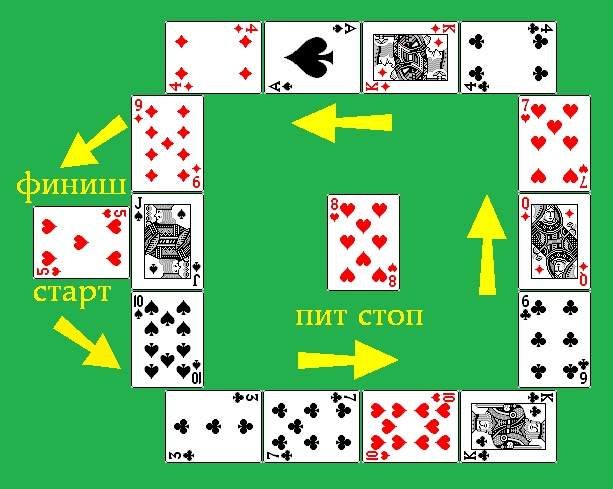Daytona (Daytona)
Number of decks: 2
Number of cards in pack: 52 + 2 jokers
Number of Players: 2-4
Precedence cards: T, 2, 3, 4, 5, 6, 7, 8, 9, 10, C, E, K.
Goal of the game: the first to get a certain number of points.
Rules of the game.
Game Description shared James Thomas.
Game Daytona invented obviously fans of racing.
Name of the game took place in honor of the Ferrari Daytona car, which was produced from 1968 to 1973.
Although the car was named Ferrari 365 GTB / 4 Daytona name he received at first unofficially by the media, but only after the most by Ferrari after the race "24 Hours of Daytona."
The game is played by two to four players, inclusive play with two decks of 52 cards and has added 2 jokers in each deck. To play the game using chips, tokens or coins that represent the cars. Before the game, anyone, if this is not something chosen by lot, puts road games.

The track is laid out as follows. Shuffled decks of the two track deliverer spreads of 14 cards and a rectangle where the track 4 and the top and bottom of the track 3 left and right. On the left side is laid out another card, which is the start and finish at the same time in the game with this game is the place begins and ends. The track should not be more than two cards of the same value, if in the process of putting some such card comes, it is placed under the bottom of the deck and laid out the next card. Also, two cards of the same value need not be contiguous with each other. The track should not be the jokers and twos. The last card is laid out on the track it is a pit stop - a map in the center of the track. This card does not match its value with any card on the track, and this card can not be a joker or deuce. The remaining cards are placed side by side in a closed form in the stack.
Then begins the actual game, which takes place between the players in a clockwise direction, and the chips are moving on the track counterclockwise. So, the players chips are placed at the start. The player who goes first is determined in any way by agreement between the players: by lot, the player left of the deliverer, etc. The player who goes first, draws a card from the top of the rest of the deck, watching its value, showing her all and lays next to a pile face down. If this card is located at one or two values of the road map (regardless of suit) before the chip is located, the chip can be placed on it. For example, in our case, the first card ♥ 5 ♠ and the player took 7 so he can put a chip on the five of hearts, if the player would have taken ♣ 9, the player chip would remain in place. If a player takes a joker, he moves his piece on one card to come. This rule applies only to finish the game. Once a player has held all the track and reach the finish line - card ♥ 5, then to pass it, the player must draw a card by value within a single unit, for example ♥ 6 Joker for the last card of passage - the finish line is not valid, that is, the joker can not pass ♥ 5. If you take the player's card is not suitable for moving the chips, then the player loses his turn and may still have one card runs back if the previous card is in one or two values taken from the card. For example, the chip is on the map ♣ 7 ♣ and the player took a 5, then he puts a chip on one card back. If it happens that the draw for travel on one card, both forward and backward, the player goes back. And yet, if a player draws a card of the same value as the pit stop the card, the player skips to 2 stroke from each player and then can walk normally. Thus, the players pass the course. The winner gets 10 points, second place gets 5 points, for the third 2 points. The number of points needed to win stipulate players before the first game. The cost of card with glasses: King - 13 points, Queen - 12 points, Jack - 11 points, the other cards at their face value, Ace - 1 point, deuce - may count as 2 points and can replace the joker in the game.


Comments
Commenting, keep in mind that the content and the tone of your messages can hurt the feelings of real people, show respect and tolerance to his interlocutors, even if you do not share their opinion, your behavior in terms of freedom of speech and anonymity offered by the Internet, is changing not only virtual, but real world. All comments are hidden from the index, spam control.